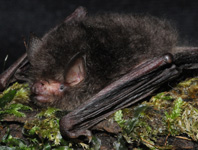Abstract
Calochromini is a net-winged beetle lineage with seven genera and world-wide distribution. The recently collected morphologically divergent Calochromus amabilis Lea, 1899 was sequenced to recover its relationships and a three-marker DNA dataset was assembled from 27 Calochromini from GenBank and new data for C. amabilis. The phylogenetic analysis recovered C. amabilis nested deep within Calochromus s. l. in a sister-position to Calochromus s. str. C. amabilis represents an early diversified and morphologically distinct species, for which the subgenus Escalonius subgen. nov. is erected. In contrast with its phylogenetic relationships, Escalonius subgen. nov. differs from other morphologically uniform Calochromus subgenera. Calochromus (Escalonius) amabilis has a small body, serrate antennae, the pronotum with concave lateral margins, and the long phallus surpassing the apices of parameres. The results demonstrate the unlinked morphological and molecular evolution of Calochromini.
The key to world genera and subgenera is presented and all diagnostic characters are illustrated.
References
ABRS (2009) Australian Faunal Directory. Calochromus. Australian Biological Resources Study, Canberra. Available from: https://biodiversity.org.au/afd/taxa/Calochromus (Accessed 14 November 2016)
Bocak, L. & Bocakova, M. (1990) Revision of the supergeneric classification of the family Lycidae (Coleoptera). Polskie Pismo Entomologiczne, 59, 623–676.
Bocak, L. & Bocakova, M. (2008) Phylogeny and classification of the family Lycidae (Insecta: Coleoptera). Annales Zoologici, 58, 695–720.
https://doi.org/10.3161/000345408X396639Bocak, L., Bocakova, M., Hunt, T. & Vogler, A.P. (2008) Multiple ancient origins of neoteny in Lycidae (Coleoptera): consequences for ecology and macroevolution. Proceedings of the Royal Society B, 275, 2015–2023.
https://doi.org/10.1098/rspb.2008.0476Bocakova, M. (1992) Revision of the genus Calochromus Guérin-Méneville (Coleoptera, Lycidae) from New Guinea and adjacent islands. Acta Entomologica Bohemoslovaca, 89, 301–308.
Costa, C. & Vanin, SA. (2012) Descriptions of Macrolygistopterus subparallelus Pic, 1930 immatures from southeastern Brazil (Coleoptera, Lycidae, Lycinae, Calochromini). Zootaxa, 3403, 54–60.
Drummond, AJ. & Rambaut, A. (2007) BEAST: Bayesian evolutionary analysis by sampling trees. BMC Evolutionary Biology, 7, 214.
https://doi.org/10.1186/1471-2148-7-214Hall, R. (1998) The plate tectonics of Cenozoic SE Asia and the distribution of land and sea. Evolution, 10, 99–131.
Hennig, W. (1966) Phylogenetic Systematics. University of Illinois Press. Urbana, III + 263 pp.
Katoh, K. & Standley, DM. (2013) MAFFT Multiple Sequence Alignment Software Version 7: Improvements in Performance and Usability. Molecular Biology and Evolution, 30, 772–780.
https://doi.org/10.1093/molbev/mst010Kleine, R. (1928) Neue Indische Lyciden nebst faunistichen Bemerkungen. Indian Forest Records, 13, 221–268.
Kleine, R. (1933) Coleopterorum Catalogus auspiciis et auxilio W. Junk editus S. Schenkling. Pars 128. Lycidae. W. Junk, Berlin, 145 pp.
Lacordaire, JT. (1857) Histoire Naturelle des Insectes. Genera des Coléopteres. Vol. 4. Libraire Encyclopédique de Roret, Paris, 579 pp.
Lanfear, R., Frandsen, P.B., Wright, A.M., Senfeld, T. & Calcott, B. (2016) PartitionFinder 2: new methods for selecting partitioned models of evolution for molecular and morphological phylogenetic analyses. Molecular Biology and Evolution, 34, 772–773.
https://doi.org/10.1093/molbev/msw260Lea, A.M. (1899) Description of new species of Australian Coleoptera. Part V. Proceedings of the Linnean Society of New South Wales, 23, 521–645.
Miller, MA., Pfeiffer, W. & Schwartz, T. (2010) Creating the CIPRES Science Gateway for inference of large phylogenetic trees. Proceedings of the Gateway Computing Environments Workshop (GCE), New Orleans, LA, pp. 1–8.
https://doi.org/10.1109/GCE.2010.5676129Motyka, M. & Bocak, L. (2015) The classification of Flabellochromus and Dumbrellia (Coleoptera: Lycidae) with descriptions of two new species of Calochromus from the Sundaland Region. Zootaxa, 3941 (1), 125–130.
https://doi.org/10.11646/zootaxa.3941.1.7Motyka, M., Masek, M. & Bocak, L. (2017) Congruence between morphology and molecular phylogeny: the reclassification of Calochromini (Coleoptera: Lycidae) and their dispersal history. Zoological Journal of the Linnean Society, 180, 47–65.
Ramsdale, A.S. (2007) A new species of Calochromus Guérin-Méneville (Coleoptera: Lycidae) from Fiji. Zootaxa, 1625, 43–46.
Ronquist, F., Teslenko, M., Mark, P., Ayres, DL., Darling, A., Höhna, S., Larget, B., Liu, L., Suchard, MA. & Huelsenbeck, JP. (2012) MrBayes 3.2: Efficient Bayesian Phylogenetic Inference and Model Choice Across a Large Model Space. Systematic Biology, 30, 539–542.
https://doi.org/10.1093/sysbio/sys029Sklenarova, K., Chesters, D. & Bocak, L. (2013) Phylogeography of poorly dispersing net-winged beetles: a role of drifting India in the origin of Afrotropical and Oriental fauna. PLoS ONE, 8, e67957.
https://doi.org/10.1371/journal.pone.0067957Stamatakis, A. (2014) RAxML Version 8: A tool for Phylogenetic Analysis and Post-Analysis of Large Phylogenies. Bioinformatics, 30, 1312–1313.
https://doi.org/10.1093/bioinformatics/btu033Wheeler, Q., Assis, L. & Rieppel, O. (2013) Heed the father of cladistics. Nature, 496, 295–296.
https://doi.org/10.1038/496295a

